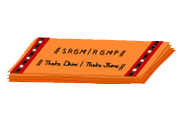Posted By: Administrator
Rāga: Rāgamālikā
Thāḷa: Miśhrachāpu
Composer: Tanjore Quartet
Language: Thelugu
Meaning – Word by
word:
Meaning –
Overall: Team Ambalam
Alignment,
Diacriticals & consequent spelling changes, Language & grammar editing,
if any and necessary, of existing meaning: Team Ambalam
Pallavi:
Sarasijākṣhulu Jalakamāḍe Tharuṇamuna Nīvu
Achhathikijani
Sariga Chīralu Mella Chaikoni Tharuvu Nekkitu Chūsuthunduṭa Dhharmamā?
Charaṇam 1
Uṭṭi Midhanupeṭṭi Unḍeseṭṭi Palanu Aṭṭa
Kanukonikoṭṭi Paṭṭi Thāgina
Geṭṭi Thanamu Idhi Kādhaiya?
Charaṇam 2
Alla Lakṣhmivallabhhudha Vai Tholli Alare Lopala
Golla Bhāmalukūḍithivi Adhi Chellu Nīki Idhi Chellunā?
Charaṇam 3
Ilanu Ninnu Maḍi Thalachi Chūḍaga Nalugurunu
Ninnu Navuthurunu Chunu Lalitha Malayalamula
Dhāgina Bhali Bhali Re Śhrī Padhmanābhha Namosthuthe
Meaning:
Pallavi:
Sarasijākṣhulu Jalakamāḍe Tharuṇamuna Nīvu
Achhathikijani
Sariga Chīralu Mella Chaikoni Tharuvu Nekkitu Chūsuthunduṭa Dhharmamā?
Sarasijākṣhulu = lotus eyed girls
Jalakamāḍe = while taking bath
Tharuṇamuna Nīvu = exactly at that time
Achhathikijani = you come
Sariga Chīralu = silk beautiful saris.
Mella Chaikoni = slowly stealing them
Tharuvu Nekk = climbing on the tree
itu Chūsuthunduṭa = watching us like this
Dhharmamā? = does this suit you?
When we, the lotus eyed girls are bathing, you
steal our silken garments and climbing on a tree, watch us. Does this suit you?
Charanam 1
Uṭṭi Midhanupeṭṭi Unḍeseṭṭi Palanu Aṭṭa
Kanukonikoṭṭi Paṭṭi Thāgina
Geṭṭi Thanamu Idhi Kādhaiya?
Uṭṭi Midhanu = on the attique
peṭṭi Unḍe= i had kept it
seṭṭi Palanu = the churned butter
Aṭṭa Kanukoni= you noticed that
koṭṭi - you broke the pot
Paṭṭi Thāgina = drank all my buttermile with your cupped hands
Geṭṭi Thanamu = being shrewd or mischivious
Idhi Kādhaiya?= do you think you have done a very wise thing?
On the attic, I had kept churned butter. Having
seen that, you broke the pot and drank all the buttermilk as mischief..do you
think you have done a wise thing?
Charanam 2
Alla Lakṣhmivallabhhudha Vai Tholli Alare Lopala
Golla Bhāmalukūḍithivi Adhi Chellu Nīki Idhi Chellunā?
Alla Lakṣhmi = the great goddess Lakṣhmi
Vallabhhudhavai = being husband of
Tholli Alare = you are playing pranks
Lopala= in
Golla Bhāmalu = the shepherd ladies (gopikas)
kūḍithivi = you are harrassing
Adhi Chellu Nīki Idhi Chellunā? = do you think that suits you?
Being the spouse of the great goddess Lakṣhmi,
you play pranks and harass shepherd ladies of a village..does this suit you?
Charanam 3
Ilanu Ninnu Maḍi Thalachi Chūḍaga Nalugurunu
Ninnu Navuthurunu Chunu Lalitha Malayalamula
Dhāgina Bhali Bhali Re Śhrī Padhmanābhha Namosthuthe
Ilanu = this way
Ninnu = you
Maḍi Thalachi = my heart pines for you
Chūḍaga = and want to see you always
Nalugurunu = all the people
Ninnu= at you
Navuthurunu Chunu = laughing and joking about you
Lalitha Malayalamula = beautiful mountain
Dhāgina = you hide yourself
Bhali Bhali Re = hail to you
Śhrī Padhmanābhha = o lord Vishnu
Namosthuthe = i bow down to you, or I salute you.
In this way, my heart pines for you and want to
see you always, though all the people laugh and joke about you. You hide
yourself in the beautiful mountain area, O Padhmanābhha and I salute you. Hail
to you!












